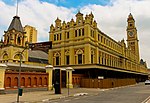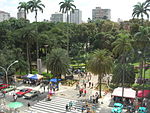Júlio Prestes (CPTM)
Companhia Paulista de Trens Metropolitanos stationsMusic venues completed in 1938Music venues in São PauloRailway stations opened in 1938

Júlio Prestes is a train station on ViaMobilidade Line 8-Diamond, located in the district of Santa Cecília in São Paulo. This historical station was named after former Governor of São Paulo and former President-elect of Brazil, Júlio Prestes. Currently, the station attends only the Line 8-Diamond. The station is the head office of the State Secretariat of Culture of São Paulo and, since 1999, the concert house for the São Paulo Symphonic Orchestra (Osesp), Sala São Paulo. In Praça Júlio Prestes, it is possible to see the bronze statue of Alfredo Maia and the iron abstract structure of Emanoel Araújo.
Excerpt from the Wikipedia article Júlio Prestes (CPTM) (License: CC BY-SA 3.0, Authors, Images).Júlio Prestes (CPTM)
Alameda Cleveland, São Paulo Campos Elísios (Santa Cecília)
Geographical coordinates (GPS) Address External links Nearby Places Show on map
Geographical coordinates (GPS)
| Latitude | Longitude |
|---|---|
| N -23.532778 ° | E -46.640833 ° |
Address
Júlio Prestes
Alameda Cleveland
01218-020 São Paulo, Campos Elísios (Santa Cecília)
São Paulo, Brazil
Open on Google Maps











